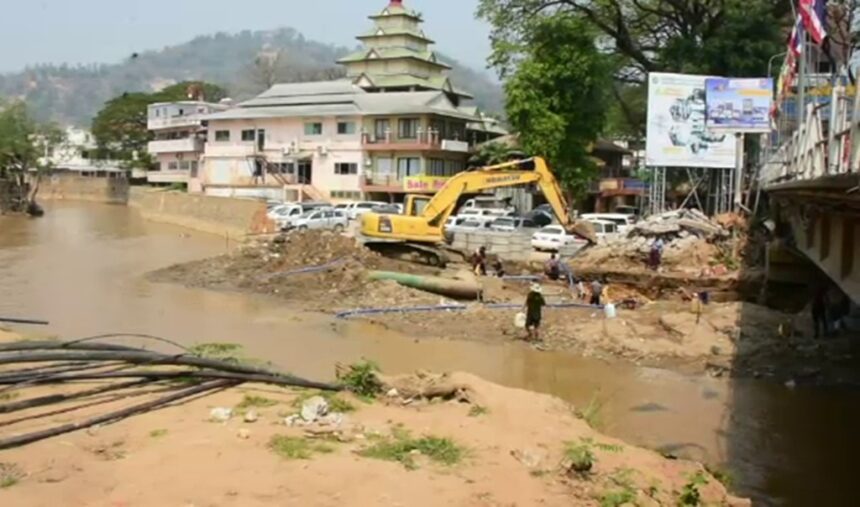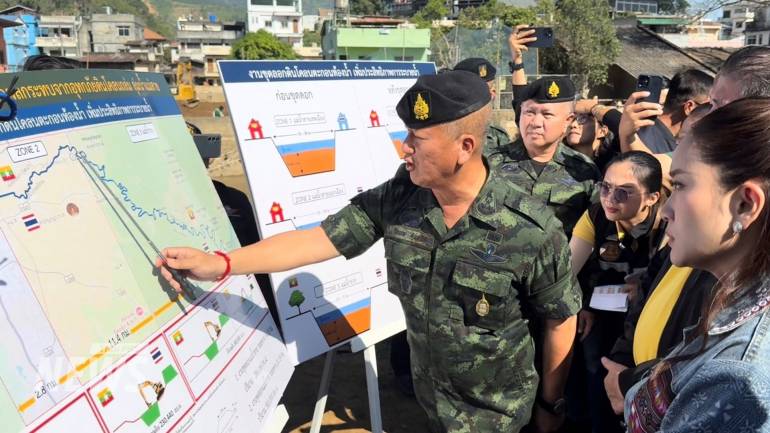Chiang Rai – Efforts are underway by Thailand and Myanmar to manage areas along the Sai River, focusing on dredging and constructing embankments to address flooding. Some residents in Mae Sai District are being forced to dismantle their homes.
Authorities from Thailand and Myanmar are urgently working on the Sai River in Mae Sai District, Chiang Rai Province. The objective is to dredge and build embankments to tackle flooding issues affecting both countries.
One of the 45 affected areas on the Thai side includes Wat Koh Sai in Mae Sai Subdistrict. At this location, five structures have already been dismantled, with roofs and frames removed, awaiting final clearance by the authorities.
Phra Sam Chinawaro, acting abbot of Wat Koh Sai, stated that the flood prevention project requires the temple to remove its bathrooms and dining hall. Military officials pointed out that these structures encroach on Myanmar’s territory.
In addition to the temple, over 30 nearby homes are reportedly beyond the boundary line. While residents haven’t opposed the removal, many acknowledged that the area was once a wide river. Over time, new land formed, and people settled there without realizing they were encroaching on a neighbouring country.
To resolve the issue, obstructions in the river and areas extending beyond national boundaries must be cleared. On the Thai side, 45 sites have been identified, while Myanmar has confirmed 33 sites. Myanmar has already demolished most of the encroaching structures and made significant progress in building a new wall.
Meanwhile, Thailand’s clearing efforts remain incomplete, delaying Myanmar from proceeding with river dredging. Thai authorities aim to finish the work by late March or early April. Any further delays could mean the project won’t be ready before the upcoming rainy season.
Experts Warn of Flood Risks in the Upcoming Rainy Season
Tanapol Piman, head of water management research at the Stockholm Environment Institute Asia Centre, highlighted concerns about sediment in the Sai River. Mining activities upstream in Myanmar’s Shan State have worsened conditions for communities downstream.
The increased sediment has made the river murkier. Last September’s mudslide in Mae Sai may have been linked to these mining operations. Without intervention, another mudslide could occur during this year’s rainy season.
The deteriorating condition of the river’s source, flagged last year, remains unaddressed, with no inspections or studies on the long-term impacts, including possible contamination.
In late 2024, reports, including one from Thailand’s Department of Natural Resources, identified large-scale gold mining along the Sai River in eastern Mong Hsat as a major contributor to the severe mud-filled floods that struck Mae Sai.
These mining operations, which have grown significantly in recent years, are carried out by Chinese companies operating in areas controlled by the United Wa State Army (UWSA) and militias aligned with Myanmar’s military regime.
The mining process involves flattening hillsides, creating large ponds filled with toxic chemicals like cyanide, and discharging vast amounts of sediment and runoff into the Sai River. This river, a tributary of the Mekong, feeds directly into Mae Sai.
The flooding in August and September 2024 wasn’t just water—it was thick mud filled with sediment containing heavy metals like zinc at levels up to 18 times above safe limits. Unlike typical seasonal floods, the Sai River carried unprecedented amounts of sludge, making cleanup in Mae Sai a 45-day struggle.
Upstream deforestation and mining activities removed natural protections, causing increased runoff during heavy rains, such as those brought by Typhoon Yagi in September 2024. Downstream areas, including Mae Sai and nearby Tachileik in Myanmar, suffered extensive damage, with homes destroyed, water sources contaminated, and residents facing health risks from toxic residues.
While rainfall contributed to the disaster, the environmental destruction caused by mining was the driving factor.
Since Myanmar’s 2021 military coup, minimal regulation has allowed mining operations, often linked to the UWSA, to expand unchecked. Chinese companies have been ramping up activity since 2022.
Local reports also highlight similar pollution in the Kok River, another Mekong tributary. This points to a wider issue where upstream mining is wreaking havoc on ecosystems and communities downstream in both Myanmar and Thailand.















